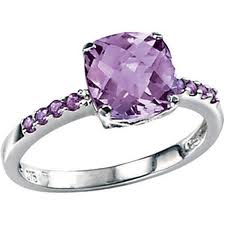Even though this month is known for red roses and pink hearts, the rich violet gemstone, Amethyst is the traditional birthstone that has been associated with love, fertility and romance long before Hallmark Cards took February’s center stage.
Cleopatra & Saint Valentines wore Amethyst…
Though Egyptian pharaohs generally adorned their tombs with Amethysts, Cleopatra wore hers on a spectacular signet ring symbolizing love, light and life.
Cleopatra was thought to be the incarnation of Isis by Egyptians, and some Romans thought she was the incarnation of Venus, Goddess of Love. With her Amethyst ring, Cleopatra was said to have enchanted not one, but two powerful Roman generals: Julius Caesar and Marc Antony. Perhaps it is the reason that Roman wives came to believe that Amethyst beaded jewelry would assure their husband’s devotion.
Amethyst is also thought to be the favorite stone of Saint Valentine, who wore an Amethyst ring carved in the shape of his assistant, Cupid.
Amethyst is a violet variety of quartz …
Amethyst occurs in primary hues from a light pinkish violet to a deep purple. Amethyst may exhibit one or both secondary hues, red and blue. The ideal grade is called “Deep Siberian.”
The gift of Amethyst is symbolic of protection and the power to overcome difficulty. Many believe it strengthens the bond in a love relationship, so it is an ideal anniversary or engagement gem.
Hard & Durable…
February’s birthstone registers as a 7 on the Mohs hardness scale, which means that it’s durable. One drawback to February’s birthstone, however, is that daylight can change its color, so to preserve the intense royal color, it’s best not to wear amethyst beaded jewelry when sunbathing or otherwise exposed to intense light.
It’s Greek to me…
The name comes from the Ancient Greek “not” intoxicated,” a reference to the belief that the stone protected its owner from drunkenness; the ancient Greeks and Romans wore amethyst in the belief that it would prevent intoxication. Wine goblets were often carved from it, and the gemstone still symbolizes sobriety to this day.
Amethyst is associated with spirituality, wisdom, sobriety, and security. According to old legend and general beliefs worldwide, amethyst is considered to make the wearer calm and in control of his various emotional levels.
Don’t Mess with Greek Gods, or Goddesses…
According to Greek mythology, amethyst was rock crystal dyed purple by the tears of Dionysus, the god of wine and revelry.
Amethyst was a young virgin who became the object of wrath of Greek God Dionysus, after he became intoxicated with red wine. When Amethyst cried out to Goddess Diana for help, she immediately turned the girl into a white, shimmering stone (quartz). When Dionysus realized what had happened and felt remorse for his actions, his tears dripped into his goblet of red wine. The goblet overturned, and the red wine spilled all over the white rock, saturating it until it became the purple quartz that is now known as Amethyst.

Perfect for birthday or anniversary…
Amethyst is the birthstone for the month of February, and the gemstone for the 6th anniversary of marriage. The stone is included in royal collections all over the world, from ancient Egypt to the British crown jewels.
Other interesting facts…
Amethyst has been thought to have many attributes throughout history, and all of them are good. The stone was thought to control evil thoughts, quicken intelligence, make a shrewd man in business, preserve soldiers from battle wounds, aid the warrior to victory, help the hunter in search of his game, protect the wearer from contagious diseases, and put demons to flight if the figure of a bear is inscribed on the jewel. Amethyst was known as a gem that would bring forth the highest, purest aspirations of human kind. Chastity, sobriety, and control over one’s thoughts were all attributes heightened by wearing the stone. The gem would guard against the anger of passion, and the violent or base nature of its wearer. The stone encouraged calm, bravery, and contemplation.
In modern times, amethyst is a symbol of clear-headedness and an open heart.





